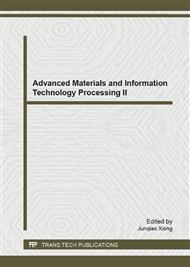[1]
A.D. Angola, G. Carbone, L. Mangilalardi, C. Serio, Non-linear oscillations in a passive magnetic suspension, Inter. J. nonlin. Mech., 41(9)(2006): 1039-1049.
DOI: 10.1016/j.ijnonlinmec.2006.10.013
Google Scholar
[2]
E. Bonisoli, A. Vigliani, Passive elasto-magnetic suspensions: nonlinear models and experimental outcomes, J. Mech. Res. Commun., 37(4)(2007): 385-394.
DOI: 10.1016/j.mechrescom.2007.02.005
Google Scholar
[3]
E. puppin, V. Fratello, Vibration isolation with magnet springs, J. Rev. Sci. Instrum., 73(11)(2002): 4034-4036.
DOI: 10.1063/1.1512325
Google Scholar
[4]
K. -B. Choi, Y. G. Cho, T. Shishi, A. Shimokohbe, Stabilization of one degree-of- freedom control type levitation table with magnet repulsive forces, J. Mechtronics., 13(6)(2003): 587-603.
DOI: 10.1016/s0957-4158(02)00032-6
Google Scholar
[5]
W. S. Robertson, M.R.F. Kidner, B. S. Cazzolato, A. C. Zander, Theoretical design parameters for a quasi-zero stiffness magnetic spring for vibration isolation, J. Sound. Vib., 326(1)(2009): 88-103.
DOI: 10.1016/j.jsv.2009.04.015
Google Scholar
[6]
W. Robertson, B. Cazzolato, A. Zander, Theoretical analysis of a non-contact spring with inclined permanent magnets for load-independent resonance frequency, J. Sound. Vib., 331(6)(2012): 1331-1341.
DOI: 10.1016/j.jsv.2011.11.011
Google Scholar
[7]
Y. Zhu, Q. Li, D. Xu, M. Zhang, Modeling of axial magnetic force and stiffness of ring-shaped permanent magnets passive vibration isolator and its vibration isolating experiment, IEEE. Trans. Magn., DOI: 10. 1109/TMAG. 2012. 2188638.
DOI: 10.1109/tmag.2012.2188638
Google Scholar
[8]
A. Carrella, M.J. Brennan, T.P. Waers, K. Shin, On the design of a high-static-low-dynamic stiffness isolator using linear mechanical springs, J. Sound. Vib., 2008, 315(3): 712-720.
DOI: 10.1016/j.jsv.2008.01.046
Google Scholar
[9]
N. Zhou, K. Liu, A tunable high-static-low-dynamic stiffness vibration isolator, J. Sound. Vib., 329(9)(2010): 1254-1273.
DOI: 10.1016/j.jsv.2009.11.001
Google Scholar
[10]
G. Coppola, K. Liu, Control of a unique active vibration with a phase comensation technique and automatic on/off switching, J. Sound. Vib., 329(25)(2010): 5233-5248.
DOI: 10.1016/j.jsv.2010.06.025
Google Scholar
[11]
M. Hoque, T. Mizuno, Y. Ishino,M. Takasaki, A 3-dof modular vibration isolation system using zero-power magnetic suspension with adjustable negative stiffness, Proc. of the 11th IEEE Conference on Advanced Motion Control, Nagaoka, Japan, pp: 660-666, (2010).
DOI: 10.1109/amc.2010.5464051
Google Scholar
[12]
A.A. Muniain, N.G. Negrete, L. Kari, Direct energy flow measurement in magneto- sensitive vibration isolator systems, J. Sound. Vib., 331(9)(2012): 1994-(2006).
DOI: 10.1016/j.jsv.2012.01.015
Google Scholar
[13]
S. Earnshaw, On the nature of the molecular forces which regulate the constitution of the luminiferous ether, Trans. Cambridge Philos. Soc., 7(1)(1842): 97-112.
Google Scholar
[14]
K. Nagaya, M. Ishikawa, A nocontact permanent magnet levitation table with electromagnetic control and its vibration isolation method using direct disturbance cancellation combining optimal regulations, IEEE. Trans. Magn., 31(1)(1995): 885-895.
DOI: 10.1109/20.364582
Google Scholar
[15]
K. Nagaya, M. Sgiura, A method for obtaining a linear spring for a permanent magnet levitation system using electromagnetic control, IEEE Trans. Magn., 31(3) (1995): 2332-2338.
DOI: 10.1109/20.376226
Google Scholar
[16]
J. Delamare, J.P. Yonnet, E. Rulliere, A compact magnetic suspension with only one axis control, IEEE Trans. Magn., 33(6)(1994): 4746-4748.
DOI: 10.1109/20.334209
Google Scholar
[17]
C. Ding, J.L.G. Janssen, A.A.H. Damen, P.P.J. vanden Bosch, Modeling and control of a 6-DOF contactless electromagnetic suspension system with passive gravity compensation, Proc. of the XIX IEEE Conference on Electrical Machines, pp.1-6, (2010).
DOI: 10.1109/icelmach.2010.5607916
Google Scholar
[18]
J. M. Hensley, A. Peters, S. Chu, Active low frequency vertical vibration isolation, Rev. Sci. Instrum., 70(6)(1999): 2735-2741.
DOI: 10.1063/1.1149838
Google Scholar
[19]
Y. Kim, S. Kim, K. Park, Magnetic force driven sixe degree-of –freedom active vibration isolation system using a phase compensated velocity sensor, Rev. Sci. Instrum., 80(4)(2009): 1-6.
DOI: 10.1063/1.3117462
Google Scholar
[20]
J. Hong, K. Park, Design and control of six degree-of-freedom active vibration isolation table, Rev. Sci. Instrum., 80(4)(2010): 1-6.
Google Scholar
[21]
A. Hamler,V. Gorican, B. Stumberger, M. Jesenik, M. Trlep, Passive magnetic bearing, J. Magn. Magn. Mater., 272(3)(2004): 2379-2380.
DOI: 10.1016/j.jmmm.2003.12.972
Google Scholar
[22]
R. Bassani, Levitation of passive magnetic bearings and systems, Tribol. Int., 39(9)(2006): 963-970.
DOI: 10.1016/j.triboint.2005.10.003
Google Scholar
[23]
J. P. Yonnet, Permanent magnet bearings and couplings, IEEE Tran. Magn, 17(1) (1981): 1169-1173.
DOI: 10.1109/tmag.1981.1061166
Google Scholar


